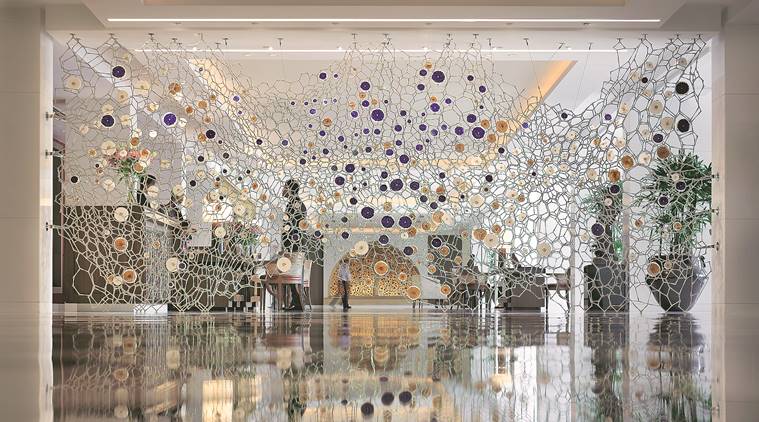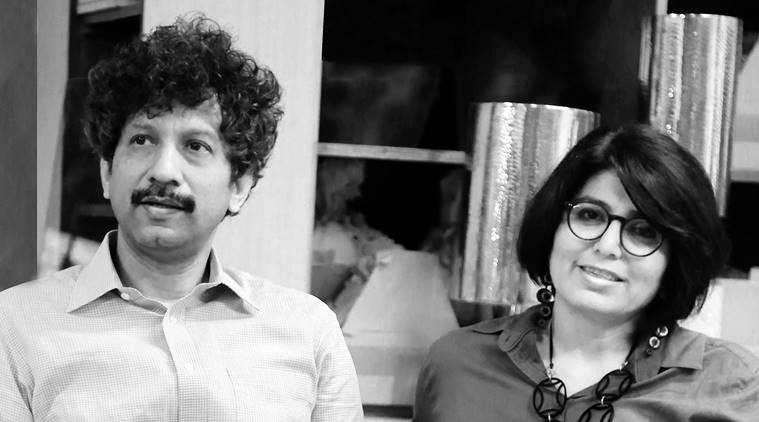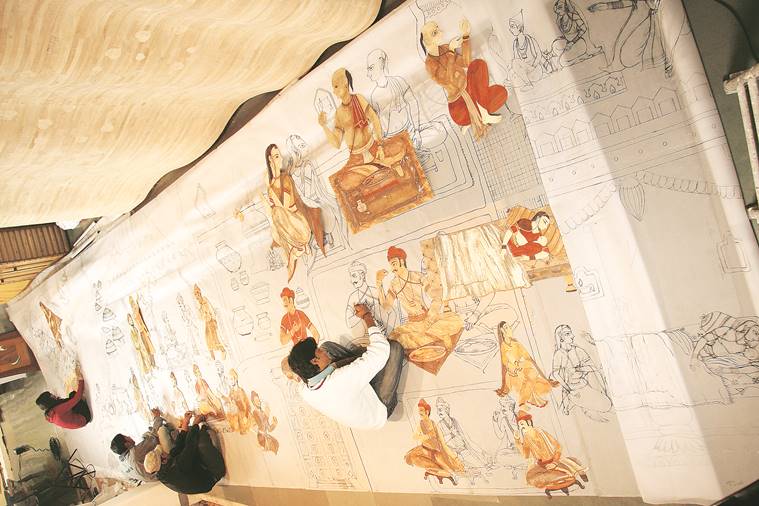Written by Shiny Varghese |Published: March 11, 2019 7:43:23 pm
Power of Translation
A new installation by the design firm Kaaru affirms their tryst with craft and consciousness

At the lobby of The Oberoi, Delhi, an intricate silvery web hangs wall to wall, floor to ceiling. Dotted at intervals with indigo blue and marigold yellow circles of varying sizes, it’s an installation that begs to be inspected further. As one draws nearer, the screen presents three layers of steel fingers hooked one to the other, and the blue and yellow reveal stone inlay of flowers on one side and compact mirrors on the other. This jagged-edged installation can only be seen through the interpretation of the word, “Atithi”.
“A guest in India is an atithi. The Sanskrit word literally means one who is without an arrival date, resonating at a deeper level with the inevitable and profound truth of impermanence, which we perceive through the ever-changing nature of time,” says Sanjib Chatterjee. This latest installation is a consequence of the 20-year journey of the design firm Kaaru that he co-founded with Anjalee Wakankar in Delhi. In this installation is the deep, slow breath of thought, of past, present and future, represented in overlapping screens, while its varying polygonal shapes brings to memory our body’s building blocks of altering cells and tissues. With artisans from Agra, who crafted the inlay, to the Aranmula mirrors done in Kerala, it presents Kaaru as translators, who take idioms of vernacular thought and present it in an urban language.

Chatterjee, an architect from Delhi’s School of Planning and Architecture, with Wakankar, who worked with artisans in Vietnam and Cambodia, started their firm at a time when home and craft were not synonymous with everyday life. When we see Gond paintings on wooden boxes today or Sanjhi screen panels in living rooms, it helps to remember that these translations took a long road to get here. Craft revivalist Rajeev Sethi’s exhibitions on Indian crafts in Smithsonian and Cooper-Hewitt in 1985 had artisans collaborate with western designers. From tables with brass and Warli inlays to wooden cabinets lined with silk fabric, Sethi showed that Indian crafts were ready to meet the challenges of the 21st century. However, in the country, there were few who worked in bringing craft home.
Wakankar recalls one of their first projects in 2000, when the temples of Khajuraho were filled with its millennium celebrations. It also marked the beginning of Kaaru’s collaboration with artisans. They worked to create a museum line of souvenirs inspired by the temples by using several craft forms of Madhya Pradesh, which were also presented to the then president KR Narayanan.
This is when they met the master artist Jangarh Singh Shyam, for whom it was the first time when he transformed his artwork from canvas to an actual product. “My prior work experience and Jangarh’s spirit of a true artist, hungry to explore, taught that an open- minded authentic spirit to collaborate with mutual respect for each other’s strengths was the foundation. Understanding the unique cultural nuances, the sensibilities and sensitivities of diverse traditions, and the potential of the individual artisan is imperative. However, as designers or design entrepreneurs, we venture out with our vision bearing the mantle of creating works wherein tradition and contemporary grow simultaneously into an evolutionary cycle of limitless possibilities,” says Wakankar.
They have collaborated with artisans across the country, translating crafts onto stone, wood, cloth and metal. Believers in the handmade and industrial heft, their products affirm Amartya Sen’s questions on the function an object performs: “Does it nourish us? Does it increase one’s accessibility to the community? Does it enhance freedom?”

One such example is of Pattachitra artists who painted the creation of the universe on the entrance door of a residence in Golf Links, Delhi. Matsya, an avatar of Vishnu, guides the sage Manu and all of humanity on a boat through the floods. Kaaru had done the interiors for this house, which also had sandstone artists from Gwalior create a screen wall depicting waves.
If at a corporate office in Gurugram (2007) Kaaru worked with 11 different craft forms, including mandlas from Madhya Pradesh on doors and panels, textiles from Chanderi, and Mysore wood inlay for the conference room and CEO offices, in the first phase (2008-10) of the Viraat-e-Khalsa Heritage Centre, Anandpur Sahib, they got carpet weavers from Mirzapur and zardozi embroiders from Agra and Lucknow to make tapestries that were nearly 50 ft long. From durrie installations depicting Guru Nanak’s Kartarpur village to textile panels in gold tissue and white organza embroidered in zardozi threads that recreated the interior ambiance of the Golden Temple, Kaaru brought to the fore the idea that teamwork and detailing made all the difference in delivery. “When a person from a village salutes the earth for his food, he registers his debt to the earth. When such knowledge seeps into feeling is when the prayers come and become action. It’s a job of a lifetime,” says Chatterjee.






















No hay comentarios:
Publicar un comentario